Once upon a time, in ancient Greece, there was a hero of immense strength and courage named Hercules. He was the son of Zeus, the king of the gods, and Alcmene, a mortal woman. From a young age, Hercules exhibited extraordinary strength and bravery, which set him apart from ordinary mortals. However, his divine lineage also brought him the wrath of Hera, Zeus's jealous wife. Driven by her hatred, Hera cast a spell of madness upon Hercules, causing him to commit a tragic act of violence against his own family. In his remorse and search for redemption, Hercules sought guidance from the Oracle of Delphi. The Oracle instructed him to serve King Eurystheus of Tiryns and complete ten seemingly impossible labors as penance. Hercules's first task was to slay the Nemean Lion, a monstrous beast that terrorized the region of Nemea. The lion had skin that was impervious to weapons, making it a formidable opponent. Armed with only his strength and courage, Hercules ventured into the lion's lair. After a fierce struggle, he realized that his weapons were useless against the beast. Undeterred, Hercules used his immense strength to strangle the lion with his bare hands. Victorious, he skinned the lion and wore its hide as a cloak, a symbol of his triumph and protection. The second labor took Hercules to the swamps of Lerna, where he faced the Lernaean Hydra, a serpent-like creature with multiple heads. Each time Hercules decapitated one of the Hydra's heads, two more would grow in its place. To overcome this challenge, Hercules enlisted the help of his nephew Iolaus. Together, they devised a plan: Hercules would cut off each head, and Iolaus would cauterize the wound with a torch to prevent it from regenerating. After a grueling battle, they succeeded in destroying the Hydra. As a final measure, Hercules dipped his arrows in the Hydra's venom, ensuring their lethality in future battles. For his third labor, Hercules was tasked with capturing the Ceryneian Hind, a sacred deer with golden antlers and bronze hooves. This swift and elusive creature was beloved by the goddess Artemis, and harming it was strictly forbidden. Hercules spent a year pursuing the hind, finally capturing it without causing harm. He brought the hind to King Eurystheus, who was astounded by the hero's ability to complete such a delicate task without shedding blood. The fourth labor required Hercules to capture the Erymanthian Boar, a giant beast that terrorized the region of Erymanthos. Hercules chased the boar through the snow-covered mountains, finally driving it into a deep snowdrift. Using his immense strength, he subdued the boar and carried it back to Eurystheus, who, in his cowardice, hid in a large jar upon seeing the fearsome creature. Hercules's fifth labor seemed more fitting for a servant than a hero: he was to clean the Augean Stables, which housed thousands of cattle and had not been cleaned in years. Faced with this daunting task, Hercules used his intellect as well as his strength. He diverted the courses of two rivers to flow through the stables, washing away the filth in a single day. Although Eurystheus tried to deny Hercules credit for this labor by claiming it didn't count because Hercules had used the rivers, the hero's ingenuity was undeniable. Next, Hercules was sent to the Stymphalian Marshes to deal with a flock of man-eating birds with metallic feathers that could be launched like arrows. With the help of Athena, who provided him with a pair of bronze castanets, Hercules startled the birds into flight. As they took to the sky, he shot them down with his poisoned arrows, ridding the region of their deadly threat. For his seventh labor, Hercules traveled to Crete to capture the Cretan Bull, a magnificent beast that had been causing destruction throughout the island. With his incredible strength, Hercules wrestled the bull to the ground and brought it back to Eurystheus. The king, terrified by the sight of the bull, released it into the wild, where it later became one of the creatures defeated by Theseus. The eighth labor involved capturing the man-eating mares of Diomedes, the Thracian king. These fearsome horses fed on human flesh, and their savagery was unmatched. Hercules, with the help of his loyal friend Abderus, managed to subdue the mares. In a tragic turn of events, Abderus was killed by the horses. Grieving for his friend, Hercules fed Diomedes to his own mares, thus taming them. He brought the subdued horses back to Eurystheus, who set them free. The ninth labor sent Hercules to the land of the Amazons to retrieve the belt of Hippolyta, their queen. The belt was a gift from Ares, the god of war, and was highly prized. Hippolyta, impressed by Hercules's reputation, initially agreed to give him the belt. However, Hera, disguised as an Amazon warrior, incited the Amazons against Hercules. A fierce battle ensued, during which Hippolyta was killed. Hercules managed to seize the belt and return it to Eurystheus. For his tenth labor, Hercules was tasked with obtaining the cattle of Geryon, a fearsome giant with three bodies. This labor took Hercules to the end of the world, where he encountered numerous obstacles, including the two-headed dog Orthrus and Geryon's herdsman Eurytion. Hercules defeated them all and eventually faced Geryon himself. After a fierce battle, Hercules emerged victorious and drove the cattle back to Eurystheus. Although originally tasked with ten labors, Eurystheus declared that two of them did not count, forcing Hercules to undertake two additional labors. The eleventh labor involved retrieving the golden apples of the Hesperides, which were guarded by a hundred-headed dragon named Ladon. Hercules sought the help of Atlas, the titan who held up the sky. In exchange for retrieving the apples, Hercules agreed to temporarily take on Atlas's burden. Atlas, seeing a chance for freedom, tried to leave Hercules with the sky. However, Hercules cleverly tricked Atlas into taking back the sky and escaped with the apples. The final labor required Hercules to descend into the Underworld and capture Cerberus, the three-headed guardian of the underworld gates. With the guidance of Hermes and Athena, Hercules confronted Hades, the god of the underworld, and requested permission to take Cerberus. Hades agreed on the condition that Hercules capture the beast without using any weapons. Using his immense strength, Hercules wrestled Cerberus into submission and brought him to the surface. Eurystheus, terrified by the sight of the monstrous hound, begged Hercules to return Cerberus to the underworld, which he did, completing his labors. Having successfully completed the twelve labors, Hercules was absolved of his sins and earned his place among the greatest heroes of Greek mythology. Each labor tested not only his strength and courage but also his ingenuity and resilience. Hercules's story became a testament to the power of redemption and the enduring spirit of heroism. His deeds were celebrated throughout Greece, and his legacy endured for generations, inspiring countless tales of bravery and adventure.The First Labor: The Nemean Lion
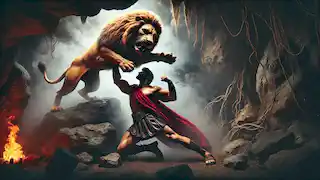
The Second Labor: The Lernaean Hydra
The Third Labor: The Ceryneian Hind
The Fourth Labor: The Erymanthian Boar
The Fifth Labor: The Augean Stables
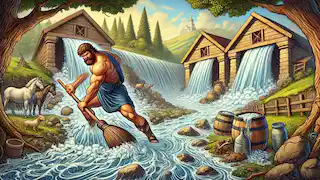
The Sixth Labor: The Stymphalian Birds
The Seventh Labor: The Cretan Bull
The Eighth Labor: The Mares of Diomedes
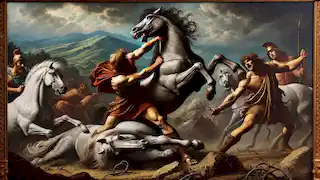
The Ninth Labor: The Belt of Hippolyta
The Tenth Labor: The Cattle of Geryon
The Eleventh Labor: The Apples of the Hesperides
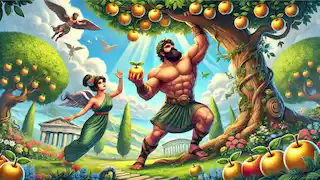
The Twelfth Labor: The Capture of Cerberus
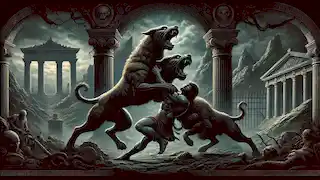
Conclusion
The Labors of Hercules
Reading Time: 7 min
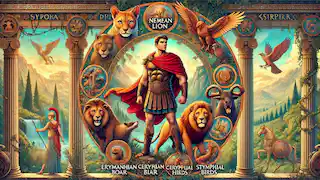
About Story: The Labors of Hercules is a Myth Stories from greece set in the Ancient Stories. This Dramatic Stories tale explores themes of Redemption Stories and is suitable for All Ages Stories. It offers Inspirational Stories insights. Witness Hercules’s heroic feats as he conquers twelve epic labors in ancient Greece.

















